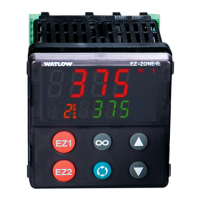Watlow EZ-ZONE
®
PM Integrated Controller • 4 • Chapter 1 Overview
A Conceptual View of the PM
The flexibility of the PM’s software and hardware al-
lows a large range of configurations. Acquiring a bet-
ter understanding of the controller’s overall function-
ality and capabilities while at the same time plan-
ning out how the controller can be used will deliver
maximum effectiveness in your application.
It is useful to think of the controller in terms of
functions; there are internal and external functions.
An input and an output would be considered external
functions where the PID calculation or a logic func-
tion would be an internal function. Information flows
from an input function to an internal function to an
output function when the controller is properly con-
figured. A single PM controller can carry out several
functions at the same time, for instance closed-loop
control, monitoring for several different alarm situ-
ations, performing logical operations and operating
switched devices, such as lights and motors. Each
process needs to be thought out carefully and the
controller’s various functions set up properly.
Input Functions
The inputs provide the information that any given
programmed procedure can act upon. In a simple
form, this information may come from an operator
pushing a button or as part of a more complex pro-
cedure it may represent a remote set point being re-
ceived from another controller.
Each analog input typically uses a thermocouple,
thermistor or RTD to read the temperature of some-
thing. It can also read volts, current or resistance, al-
lowing it to use various devices to read humidity, air
pressure, operator inputs and others values. The set-
tings in the Analog Input Menu (Setup Page) for each
analog input must be configured to match the device
connected to that input.
Each digital input reads whether a device is ac-
tive or inactive. A PM with digital input-output (DIO)
hardware can include up to eight DIO each of which
can be used as either an input or an output. Each
DIO must be configured to function as either an in-
put or output with the Direction parameter in the
Digital Input/Output Menu (Setup Page).
The Function or EZ Key on the front panel of the
PM also operates as a digital input by toggling the
function assigned to it in the Digital Input Function
parameter in the Function Key Menu (Setup Page).
Internal Functions
Functions use input signals to calculate a value. A
function may be as simple as reading a digital input
to set a state to true or false, or reading a tempera-
ture to set an alarm state to on or off. Or, it could
compare the temperature of a process to the set point
and calculate the optimal power for a heater.
To set up an internal function, it’s important to
tell it what source, or instance, to use. For example,
an alarm may be set to respond to either analog in-
put 1 or 2 (instance 1 or 2, respectively).
Output Functions
Outputs can perform various functions or actions in
response to information provided by a function, such
as operating a heater, driving a compressor, turning
a light on or off, unlocking a door etc...
Assign an output to a Function in the Output
Menu or Digital Input/Output Menu. Then select
which instance of that function will drive the select-
ed output. For example, you might assign an output
to respond to alarm 4 (instance 4) or to retransmit
the value of analog input 2 (instance 2).
You can assign more than one output to respond
to a single instance of a function. For example, alarm
2 could be used to trigger a light connected to output
1 and a siren connected to digital output 5.
Input Events and Output Events
Input and output events are internal states that are
used exclusively by profiles. The source of an event
input can come from a real-world digital input or an
output from another function. Likewise, event out-
puts may control a physical output such as an output
function block or be used as an input to another func-
tion.

